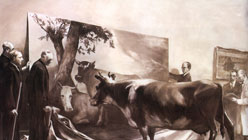Welcome to Help Desk, where I answer your queries about making, exhibiting, finding, marketing, buying, selling — or any other activity related to — contemporary art. Together, we’ll sort through some of art’s thornier issues. Email helpdesk@dailyserving.com with your questions. All submissions remain strictly anonymous and become the property of Daily Serving.
I am a visual arts writer, and if I don’t have anything nice to say, I don’t say it at all. I state my personal opinions about artwork I like and choose my subjects based on personal preference. I don’t claim to be a critic. I prefer to describe what I see in a lighthearted way, but I fear that I come across as a fluff writer, and I have actually been called out as an “overly saccharine cheerleader.” Is it ok to be consistently complimentary as an arts writer?
Your query begs for the concision of a yes/no answer, but I’m afraid I can’t give you one. Part of the difficulty is that you don’t claim to be a critic — that is to say, an evaluator of art and culture — yet you state personal opinions based on preference. Isn’t that what a critic does? I wonder if part of the issue lies in vocabulary: critic, criticism, and critique all have a whiff of the negative, yet etymologically they’re all based on the Greek kritikos, which simply indicates the ability to make judgments based on quality. So, if you’re evaluating artwork in print, then chances are your readers already consider you a critic in the traditional sense, whether you claim to be or not. Further, I think we have to separate the issue of being a critic from the manner (“lighthearted”) in which you state those opinions, and the fact that you fear fluff, but seem to limit your writing to descriptions. Based on the short question you’ve written to Help Desk, there seem to be some contradictions at work in your practice. If the accusation of being saccharine stings (as it must have, since it compelled you to write to me), then you have to think about what you hope to accomplish.

Mark Tansey, The Innocent Eye Test, 1981.
Let’s go all the way back to the fundamental question: why do you write about art? Probably you enjoy the process of looking and responding, and if that’s as deep as you want to go, that’s fine. You can continue on your complimentary way, but you’ll have to grow a thicker skin. After all, there’s a lot of art writing out there and the person who doesn’t like your nice-things-to-say style can easily go read something else. That’s a valid position to take and I support it. But if you decide that you want to participate more fully in a cultural dialog, or if you want to help artists advance their work, or if you want to be taken seriously by the arts establishment in your area, you should consider writing about work that you don’t find attractive or valuable.




